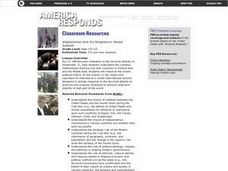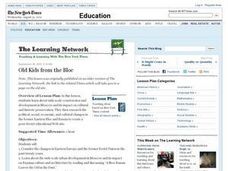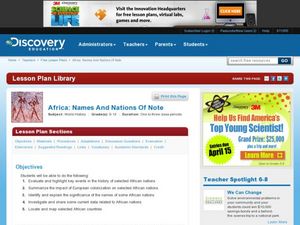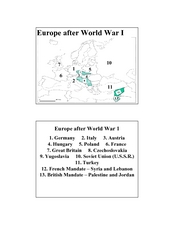Curated OER
The Soviet Union: Flashcards
Kids can use these question-style flashcards to practice memorizing states and capitals. There are 10 cards, each includes a question and answer related to the states and capitals of the Soviet Union.
Curated OER
The Former Soviet Union
In this social studies worksheet, learners find the names of the republics for the former Soviet Union and the answers are found at the bottom of the page.
Delegation of the European Union to the United States
The Geography of Europe
What is the European Union? Where is it? Why is it? To begin a study of the EU, class members examine the physical geography of Europe and the size and population density of 28-member countries in comparison to non-member countries like...
Curated OER
Out With the Old, in With the New
Students engage in a lesson that is concerned with the concept of the Soviet Union and compared to the new Democratic Russia. They conduct research using a variety of resources. The information is used in order to create a class project.
NASA
Outline Maps
Don't miss this gold mine of blank maps for your next geography lesson! Regions include traditional continents such as Asia, Europe, and Africa, as well as other major world areas such as the Pacific Rim and the Middle East.
Curated OER
NATO Geography & Language
The class receives background information on NATO, an atlas, and a blank world map. They color the original 1949 countries in red, the 1952 additions in green, and the 1990 additions in blue. This exercise would be a good starting point...
Curated OER
Geography Application: The Cuban Missile Crisis
A complete activity! The class reads the provided text, then answers the 7 critical-thinking questions. Topics covered are interpreting informational text, reading comprehension, the Cuban Missile Crisis, and US Policy.
Curated OER
The Russian Revolution
Students complete a matching game based on geographic features of Russia and label a map with these features. In this geography and politics lesson, students identify resources and populations in Russia and complete a T-Chart on a video...
Curated OER
Afghanistan Today: Civil War and Human Rights
High schoolers examine the relationship between the United States and the Soviet Union during the Cold War. They analyze the role of religion and cultural identity in shaping governments. They also examine the United States foreign...
Curated OER
Afghanistan and Its Neighbors: Model Summit
Students examine the relationship between the United States and the Soviet Union during the Cold War. They discover the role of religion and cultural identity in the war in Afghanistan. They explore the arguments for and and against...
Curated OER
Capturing the Reader With Vivid Images
Students examine how the author tries to capture the reader's imagination immediately, through imagery--and hold on to it. They locate Ukraine on a world map and understand Lenin's role in the establishment of Russian communism and the...
Curated OER
Teacher Notes
Gathering information, distinguishing between arguments, preparing an oral presentation; these skills are fostered as 10th graders explore aspects of global trade and politics. They use the Internet to gather information about NATO, The...
Curated OER
Old Kids From The Bloc
Students study about wide scale construction and development in Moscow and its impact on cultural and historic preservation. They research the political, social, economic, and cultural changes in the former Eastern Bloc and create a...
Curated OER
Africa: Names and Nations of Note
Students explore Africa. In this global studies activity, students research the history of African nations, noting the impact of European colonization and other historical events. Students design posters about the nations they research.
Curated OER
Locating The Cold War
Students identify major players in the Cold War and place them on a world map. They identify the two superpowers location on the map as well as their allies. Students analyze how the world divided itself.
Curated OER
Focus on Russia; From Communism to Capitalism
In this Russian history worksheet, students respond to 12 short answer questions about Communism and Capitalism. Students also use the provided maps of the Russia and the U.S.S.R. to help them answer the questions.
Curated OER
Which Foods Come From Rainforests?
A very interesting and colorful presentation on the original sources of food is here for you. Learners discover where foods such as bananas, asparagus, potatoes, and oranges come from. They come from rainforests located all over the world!
Curated OER
Europe after World War I
In this Europe after World War I map worksheet, young scholars note the 11 regions of the Europe labeled on the map.
Curated OER
What's Russia To Do?
Students watch a PowerPoint presentation on the Gulag system in Russia. In groups, they use the internet to create maps on climate and population pyramids for the country of Russia. They must use this information and develop a plan to...
Curated OER
World Religions
Ninth graders investigate the symbols and historical figures of the five main religions of the world. They participate in a class discussion, listen to a lecture and take notes, and write five Haikus, one about each major religion of...
Curated OER
Exploring Islamic Lands
Students examine the lives of Islamic teens. In this global studies lesson, students explore selected Internet sites to discover the attributes of Islam, the cultural traditions of Islam, and information regarding Middle Eastern...
Curated OER
You're In My Space!
Students explain how political, social, and economic boundaries can be changed through cooperation and conflict. Small groups are assigned a particular trouble area of the world. Each group studies a particular side of the conflict.
Curated OER
The Cuban Missile Crisis of 1962
Sixth graders explain the importance the Cuban Missile Crisis of 1962 and the role it played in the Cold War. After studying the crisis, 6th graders compose an essay describing the crisis and how the U.S. became vulnerable to nuclear...
Curated OER
The Chernobyl Accident
Fifth graders see that the Chernobyl Accident of 1986 was caused by a poorly developed experiment in a nuclear power plant. They explain the purpose of a nuclear power plant and determine the health effects that radioactivity causes.

























